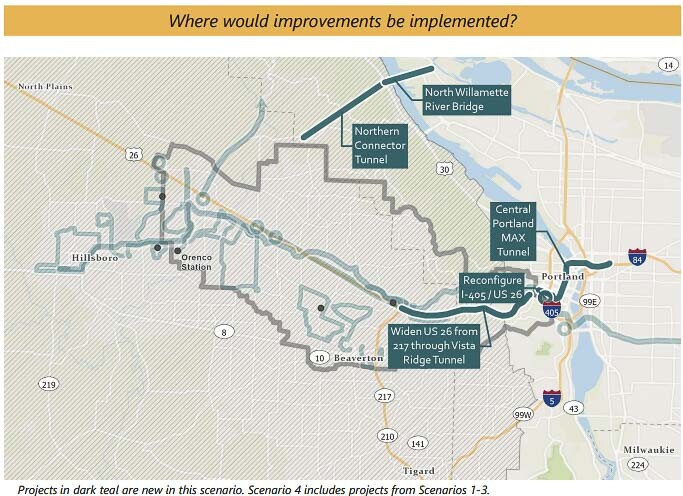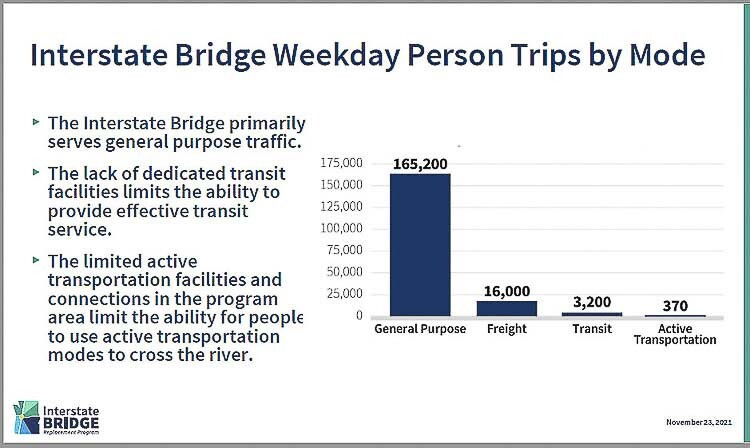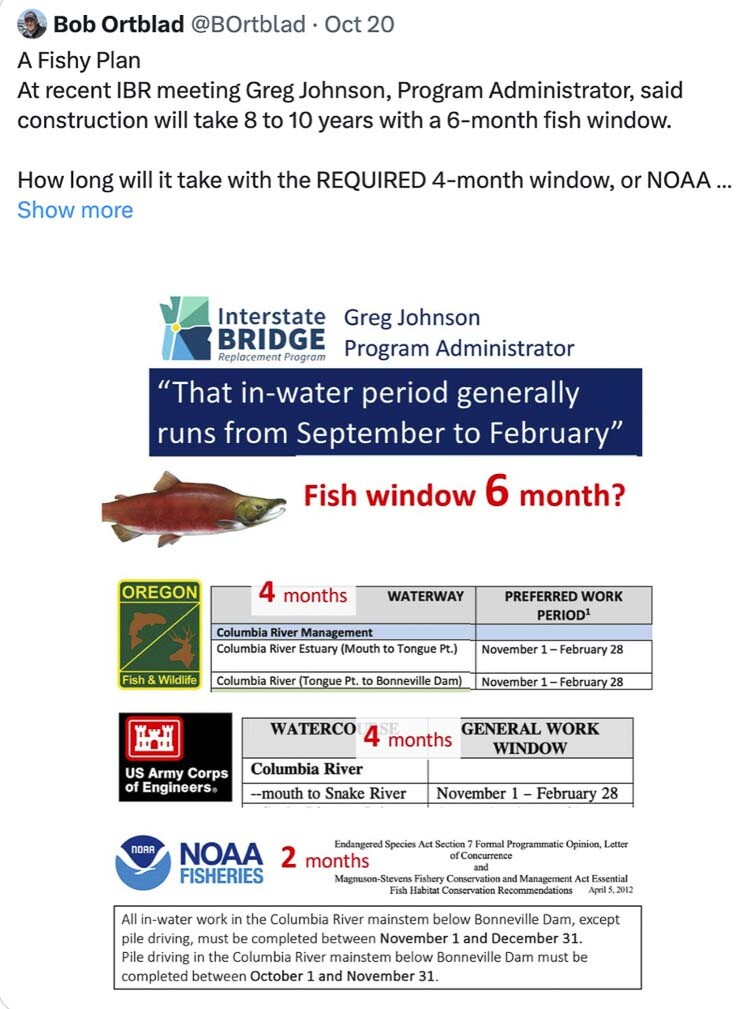3rd bridge planning discussed by Clark County Council with legislators
John Ley
for Clark County Today
For two and one half hours Friday (Dec. 15) morning, the 16-member committee of Washington and Oregon legislators who are supposed to provide oversight of the Interstate Bridge Replacement project got updates from Interstate Bridge Replacement program (IBR) Administrator Greg Johnson and his team. At the time, they hadn’t received word from the Federal Highway Administration that $600 million in federal funds was being allocated to the project. News reports indicate Vancouver Mayor Anne McEnerny Ogle and the IBR team were very nervous about being awarded any funds the day prior.
Johnson shared with the legislators that the Brent Spence Bridge project crossing the Ohio River in Cincinnati had been awarded $290 million in federal funding under the Mega Grant program. The IBR was seeking $600 million. Not mentioned was the fact that Cincinnati has six bridges over the Ohio River and the new Brent Spence will be the seventh. It will also be a toll-free bridge.
At this time, Washington and Oregon transportation officials and elected officials are not considering a third bridge to add vehicle capacity and additional transportation corridors to reduce traffic congestion. Saving time and reducing traffic congestion is the people’s top priority according to all the public surveys.

In fact, the day prior, the Clark County Council had spent considerable time discussing the need for a third bridge and transportation corridor with Southwest Washington legislators. Chair Karen Dill Bowerman led off the discussion by mentioning a recent discussion in Ridgefield about the need for a third bridge and how important that is for the community.
Councilor Michelle Belkot mentioned an Oregon Department of Transportation (ODOT) tolling meeting on Wednesday. “Any time a third corridor is mentioned, they shut down,” she said.
“We are so far behind,” added Councilor Gary Medvigy. “If we don’t plan, we’re never going to be able to afford the right-of-way.”
During the Bi-State Bridge Committee meeting of legislators, Sen. Lynda WIlson (Republican, 17th District) asked for an updated travel time and traffic congestion study. She noted the Oregon Rose Quarter project is not funded and now on hold. Current IBR travel times include completion of the Rose Quarter project. That brought immediate push back from Oregon Sen. Chris Gorsek (Democrat, 25th District) who said “the Rose Quarter will be funded.”
Yet, Oregon Gov. Tina Kotek has expressed her displeasure with the legislature’s issuing an IOU against future General Fund revenues to pay the $750 million balance Oregon owes the i_5 Bridge replacement project. ODOT needs $1.9 billion to pay for the Rose Quarter, plus several hundred million to pay to finish the I-205 project. All this creates a significant funding challenge for the Oregon State Legislature, which had a hard time finding $5.3 billion for HB 2017 six years ago.
The IBR reports current travel time from Salmon Creek to the Fremont Bridge on I-5 is 29 minutes. The IBR team projects that with only one auxiliary lane and three lanes on the replacement bridge, travel times will more than double to 60 minutes in 2045. Furthermore, they project 50 percent of rush hour vehicles will be stuck going zero to 20 mph, up from 28 percent today.
IBR promotional materials note that traffic is congested 8 to 10 hours a day, as part of their pitch to spend up to $7.5 billion on the project. Yet they fail to tell citizens how many hours per day traffic will be congested after making the largest government expenditure in the region’s history. Where is the value, citizens want to know.
On the topic of a third bridge option, Wilson noted that Oregon is planning for a new tunnel for TriMet under the Willamette, as well as a new bridge over the Willamette River (to the Port of Portland). She wondered if that should be part of the IBR evaluation.
Johnson said they only consider things “in their long-term plans,” not specifying who “they” are. In November, ODOT and Metro briefed a Westside Multimodal Improvements Study committee on numerous transportation projects including a “Northern Connector.” It has a tunnel under the west hills and a new Willamette River bridge to the Port of Portland.

Legislators expressed significant interest in the bridge clearance issue. US Coast Guard (USCG) officials have stated the current proposal for 116 feet of clearance for maritime vessels is unacceptable. They are seeking at least the current 178 feet of clearance and would prefer unlimited clearance.
An update was provided about river clearance issues for the maritime community. This apparently was in response to a recent Clark County Today report on difficulties navigating the Columbia River, especially during construction.
Oregon Rep. Khanh Pham (Democrat 46th District) wanted to know the specific impacts of the lower bridge for the three up river fabricators. She expressed concern that future needs will be much greater than 116 feet of clearance and that we shouldn’t restrict future river users.
The IBR team is negotiating with four up river firms, three fabricators and the Columbia Business Center. They hope to determine if they can pay to mitigate the impacts of a bridge over 60 feet lower than the current structure. In the failed Columbia River Crossing (CRC), they had agreed to pay $86.4 million to the firms.
John Rudi of Thompson Metal Fab told Clark County Today “our tallest loads have been 165 feet with many over the 125-150 foot range.” He also noted that the USCG recommends a clearance buffer of no less than 10 feet.
“How much?” asked Wilson. Johnson told the legislators they have an idea, but no specific number. They have asked the firms to sign a confidentiality agreement, allegedly to protect “business secrets.” That brought pushback from several legislators who said they are the ones who will have to write the check for mitigation. They don’t want this project to become a cash cow.
Johnson responded saying the cost magnitude of a movable span would be “upwards of half a billion dollars.” It would be the largest moveable span in the world, he claimed. He also noted that nothing exceeding 116 feet has gone down the river in the past 11 years. The Arthur Kill Bridge between New Jersey and New York, has a movable section that spans 558 feet.
Yet the cost of the bridge alone is $500 million, according to the IBR. That is under 7 percent of the total project cost. Citizens might wonder why not spend more for either a movable bridge or a tunnel, in order to protect marine traffic and not build “a bridge too low.”

Staff noted there are between 300 and 400 bridge lifts each year. About half of them are for maintenance.
Light rail is the single largest component of the IBR at potentially $2 billion. The cost of interchanges in Oregon are slightly more than the cost of interchanges in Washington, at roughly $1.5 billion each.
“Do you have any idea on how much the transit stations will be,” Wilson asked. Johnson spoke about refining designs, including the cost of modifying the current Delta Park light rail station. During public comments, a citizen questioned whether or not anyone would actually be using the Vancouver waterfront station, expected to be 80 to 90 feet in the air, especially when there will be a ground level station about 2,500 feet to the north, at Evergreen Blvd.
It was also noted by Gorsek that the Steel Bridge is a significant bottleneck for TriMet’s MAX light rail. Trains are required to slow down in order to cross, with one train every 90 seconds during rush hour. There is no capacity to add additional trains until this bottleneck is fixed. TriMet has a multi-billion-dollar plan for a tunnel under the Willamette River they’ve been working on for years, but no source of funding.
A key component of gaining federal approval for the project is the planned release of the Supplemental Environmental Impact Statement (SEIS). This is expected to be released next spring. There will be a 60-day public comment period for citizens to weigh in.
Because the IBR program has chosen to keep the same Purpose and Need statement from the decade-old Columbia River Crossing (CRC) project, they will issue the supplemental EIS rather than complete an entirely new EIS. The project has discarded numerous options, including a third bridge or a tunnel, in favor of replacing a three-lane bridge with another three-lane bridge.
Recently there has been a great deal of interest in an immersed tube tunnel (ITT) option. Retired engineer Bob Ortblad fought against the IBR’s formal evaluation of an ITT which said it wasn’t a viable option. They were forced to correct their assessment that an ITT would require 8 million cubic yards of excavation. The IBR reduced it by half, yet Ortblad calculated numbers showing about 2.1 million yards.

Another issue is the window the various federal agencies allow for construction in the river. Johnson told the legislators the window is September to February. Ortblad corrected Johnson during public comment, saying it’s only four months – November to February. This restriction is for fish and aquatic marine life considerations.
An additional serious issue raised by Ortblad is the length of IBR construction. Currently the project shows construction fully complete in 8 to 10 years. Ortblad believes the time needed to build the 88 in-water support columns because of only having a 4-month construction window would naturally slow down the entire project. He projects 14 to 16 years of construction.
The Abernethy Bridge has six in-water columns to be constructed. That project will take six years, Ortblad revealed.
Portland economist Joe Cortright pointed out during public comment that the IBR is required to do a legitimate “benefit-cost analysis” and submit it to the federal government. “A $7.5 billion highway boondoggle doesn’t meet the basic test of cost-effectiveness,” he wrote. “The Interstate Bridge Project is a value-destroying proposition: it costs more to build than it provides in economic benefits.”
He previously spoke about the huge traffic diversion to I-205 due to tolling beginning in 2026. He believes at least 33,000 vehicles per day will divert due to people seeking to avoid paying the pre-construction tolls. ODOT previously told the community that 130,000 vehicles would be diverting onto side roads once tolling were implemented on all Portland area freeways.
To close out the meeting, Senator Wilson told the legislators they need to do more than simply “listen” to public comment. She lamented that they are not given any responses to the many issues the citizens raise, and that the people never get responses. Johnson said they will do better in providing those responses.
Also read:
- Opinion: Hiding the growing cost of the Interstate Bridge replacementJoe Cortright of the City Observatory addresses the rising cost of the Interstate 5 Bridge replacement project.
- 90 minutes of delay on Southbound I-5 in Southwest Washington on Friday afternoon, July 26Travelers using southbound Interstate 5 through Woodland should expect up to 90 minutes of delay during Friday afternoon and evening and should delay travel or prepare for additional travel time.
- Nighttime paving work on I-5 and SR 14 in Clark County July 28-Aug. 9Nighttime travelers in Clark County should expect delays for maintenance and paving work beginning Sunday, July 28 until the morning of Friday, Aug. 9.
- Northeast 182nd Avenue/Northeast Ward Road to be closed on Aug. 1Northeast 182nd Avenue and Northeast 172nd Avenue in Clark County will have single-day closures on August 1 and August 5 for road preservation, with detours in place.
- Interstate Bridge Replacement program awarded $1.499 billion FHWA Bridge Investment Program grantInterstate Bridge Replacement program officials have shared that the program received $1.499 billion through the Federal Highway Administration’s Bridge Investment Program.









